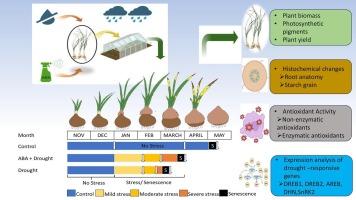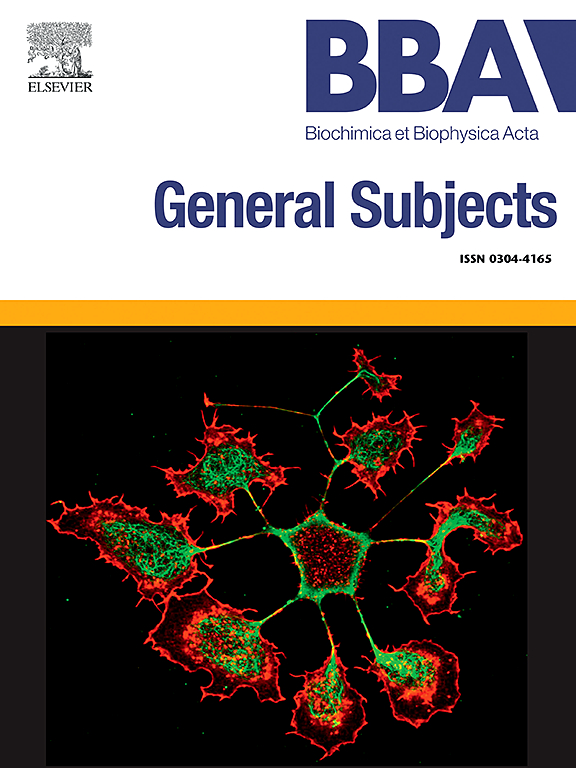Abscisic acid-mediated modulation of morpho-physiological traits and transcript accumulation improves drought resilience in Crocus sativus L.
IF 2.2
3区 生物学
Q3 BIOCHEMISTRY & MOLECULAR BIOLOGY
Biochimica et biophysica acta. General subjects
Pub Date : 2025-08-21
DOI:10.1016/j.bbagen.2025.130849
引用次数: 0
Abstract
Drought is a major abiotic factor leading to decreased productivity. The current study investigates the effects of prolonged drought stress and subsequent recovery in Crocus sativus L. through the exogenous application of abscisic acid (ABA) under field conditions in the Dhauladhar range of the Himalayan region. To evaluate the influence of drought stress, saffron corms (both large and medium) were subjected to three treatments: irrigation, water deficit (withheld irrigation), and ABA application (via foliar spray). The results indicated that morphological and physiological traits, including fresh weight and dry weight (leaf, root, mother corm and daughter corm), sprouting percentage, total biomass, flower number, stomatal aperture, relative water content, photosynthetic activity and Fv/Fm were negatively affected by drought stress. Further, histological analysis revealed a reduction in starch granule accumulation, while root metaxylem cells were found to be enlarged under water deficit conditions. Additionally, RT-PCR analysis indicated higher transcript abundance of DREB1, DREB2 and SnRK2 under drought conditions compared to the control, while the expression levels of MYB37, WRKY1, DHN1, DHN1 and AREB1 remained unchanged under similar conditions. Nevertheless, exogenous abscisic acid improved the drought tolerance of C. sativus. A decrease in lipid peroxidation and an increase in proline, chlorophyll content, and antioxidant activity were observed when ABA was applied under drought conditions. Overall, our study demonstrates ABA-mediated regulation of several key transcription factors under drought stress. These findings provide new insights into the mechanisms of drought tolerance in saffron, which will facilitate future breeding programmes for this highly valuable crop.

脱落酸介导的形态生理性状调控及转录物积累提高藏红花抗旱性。
干旱是导致生产力下降的主要非生物因素。本研究在喜马拉雅地区道拉达哈尔山脉野外条件下,通过外源施用脱落酸(ABA),研究了长时间干旱胁迫对藏红花(Crocus sativus L.)恢复的影响。为了评估干旱胁迫的影响,对藏红花球茎(包括大球茎和中球茎)进行了三种处理:灌溉、水分亏缺(保留灌溉)和ABA施用(通过叶面喷洒)。结果表明,干旱胁迫对冬小麦的形态和生理性状,包括鲜重和干重(叶、根、母、子球茎)、出芽率、总生物量、花数、气孔孔径、相对含水量、光合活性和Fv/Fm均有不利影响。此外,组织学分析显示,淀粉颗粒积累减少,而根的质量部细胞在水分不足的条件下扩大。此外,RT-PCR分析显示,干旱条件下DREB1、DREB2和SnRK2的转录丰度高于对照,而MYB37、WRKY1、DHN1、DHN1和AREB1的表达水平在相似条件下保持不变。然而,外源脱落酸提高了红花的耐旱性。在干旱条件下,施用ABA可降低脂质过氧化,增加脯氨酸、叶绿素含量和抗氧化活性。总的来说,我们的研究表明aba介导了干旱胁迫下几个关键转录因子的调控。这些发现为藏红花的耐旱机制提供了新的见解,这将促进这种高价值作物的未来育种计划。
本文章由计算机程序翻译,如有差异,请以英文原文为准。
求助全文
约1分钟内获得全文
求助全文
来源期刊

Biochimica et biophysica acta. General subjects
生物-生化与分子生物学
CiteScore
6.40
自引率
0.00%
发文量
139
审稿时长
30 days
期刊介绍:
BBA General Subjects accepts for submission either original, hypothesis-driven studies or reviews covering subjects in biochemistry and biophysics that are considered to have general interest for a wide audience. Manuscripts with interdisciplinary approaches are especially encouraged.
 求助内容:
求助内容: 应助结果提醒方式:
应助结果提醒方式:


